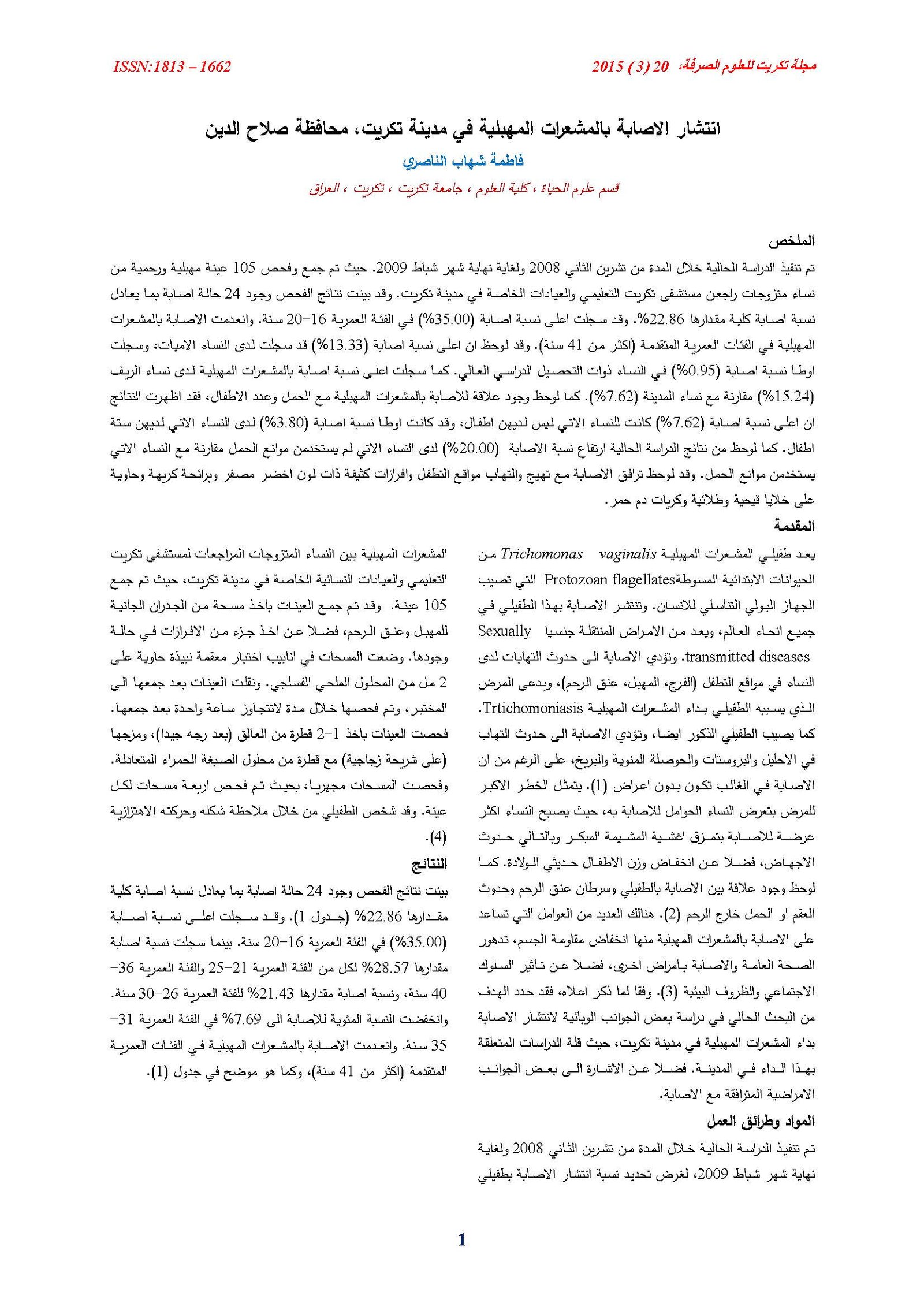Prevalence of infection with Trichomonas vaginalis in Tikreet city, Salah Al-Deen province
Main Article Content
Abstract
During the period from November 2008 till the end of February 2009, the present study was carried on. A total of 105 vaginal and uterine specimens, of married females attended Tikreet teaching Hospital and private laboratories in Tikreet city, was collected and examined. The examination results revealed that 24 women were infected (22.86%). The highest prevalence of infection (35.00%) was in the age group 16-20, with absence of infection in the women aged more than 41 year. It has been observed that the highest prevalence of infection (13.33%) was recorded in the illiterate women, and recorded lower prevalence of infection (0.95%) in women with higher academic achievement. Also, recorded the highest prevalence of infection in rural women (15.24%) compared with women in urban (7.62%). Also, in the present study noted a relationship between the infection with pregnancy and the number of children, the results show that the highest prevalence of infection (7.62%) were in the women without children, whereas the lower prevalence of infection (3.80%) were among the women have six children. Also, the highest prevalence of infection (20.00%) were in the women has not use contraception, compared with women used contraceptive materials. It has been observed the irritation and inflammation in the sites of infection with thick, yellowish-green and foul smell secretions with red blood cells, pus and epithelial cells.
Article Details

This work is licensed under a Creative Commons Attribution 4.0 International License.
Tikrit Journal of Pure Science is licensed under the Creative Commons Attribution 4.0 International License, which allows users to copy, create extracts, abstracts, and new works from the article, alter and revise the article, and make commercial use of the article (including reuse and/or resale of the article by commercial entities), provided the user gives appropriate credit (with a link to the formal publication through the relevant DOI), provides a link to the license, indicates if changes were made, and the licensor is not represented as endorsing the use made of the work. The authors hold the copyright for their published work on the Tikrit J. Pure Sci. website, while Tikrit J. Pure Sci. is responsible for appreciate citation of their work, which is released under CC-BY-4.0, enabling the unrestricted use, distribution, and reproduction of an article in any medium, provided that the original work is properly cited.
References
1- Ma, L.; Meng, Q.; Cheng, W.; Sung, Y.; Tang, P.; Hu, S. and yu, J. (2011). Involvement of GP63 protease in infection of Trichomonas vaginalis. Parasitol. Res., 109: 71-79.
2- Figueroa-Angulo, E. E.; Rendon-Gandarilla, F. J.; et al. (2012). The effects of environmental factors on the virulence of Trichomonas vaginalis. Microb. Infect., 14: 1411-1427.
3- Robinson, A. J.; Watkeys, J. E. M. and Ridgway, G. L. (1998). Sexually transmitted organisms in sexually abused children. Arch. Dis. Child., 79: 356-358.
4- Fouts, A. C. and Kraus, S. J. (1980). Trichomonas vaginalis: re-evaluation of its clinical presentation and laboratory diagnosis . J. Infect. Dis., 41:137-143.
5- Gillespie, S. H. and Pearson, R. D., eds. (2001). Principles and practice of clinical parasitology. John Wiley and Sons, New York.
6- Petrin, D.; Delgaty, K.; Bhatt, R. and Garber, G. (1998). Clinical and microbiological aspects of Trichomonas vaginalis. Clin. Microbiol. Rev., 11(2): 300-317.
7- Oladele, H.A.-W.; Oladipupo, A. A.; Olalekan, A.W. and Abiodun, A. A. (2011). Survey of trichomoniasis in Osogbo, southwestern Nigeria. Int. J. Biol. Med. Res., 2 (3): 607-610.
8- Lapage, G. (1963). Animal parasitic in man. Dover Publ., New York.
9- Piekarski, G. (1989). Medical parasitology. Springer, Berlin.
10- Pereira-Neves, A. and Benchimol, M. (2007). Phagocytosis by Trichomonas vaginalis: new insights. Biol. Cell, 99 (2): 87-101.
11- Benchimol, M.; Rosa, I. A.; Fontes, R. S. and Dias, A. J. B. (2008). Trichomonas adhere and phagocytose sperm cells: adhesion seems to be a prominent stage during interaction. Parasitol. Res., 102: 598-604.
12- Rhyan, J. C.; Wilson, K. L. and Burguess, D. E. (1988). Fetal and placental lesions in bovine abortion due Trichomonas foetus. Vet. Pathol., 25 (350-355.
13- Lewis, T. L. T. and Chamberlain, G. V. P. (1990). Gynaecology by ten teachers. 5th ed., pp.75-80.
14- Quinn, T. C. and Krieger, J. N. (1990). Trichomoniasis in tropical and geographic medicine. McGraw-Hill, New York. [Cited by: Edan, E. M. (2007). The role of specific and non specific immunological stimulators in protection of albino mice against infection with Trichomonas vaginalis. Ph.D. Thesis, Univ. Baghdad, in Arabic].
15- Kucknoor, A. S. , Mundodi,V. and Alderete, J. F.(2005). Adherence to human vaginal epithelial of cells signals for increased expression of Trichomonas vaginalis gene . Infect. Immunol., 73:6472-6478.
16- Rezaeian, M.; Vatanshenassan, M.; Rezaie, S.; Mohebali, M.; Niromana, N.; Niyyati, M.; Farnia, S. and Babaei, Z. (2009). Prevalence of Trichomonas vaginalis using parasitological methods in Tehran. Iranian J. Parasitol., 4(4): 43-47.
